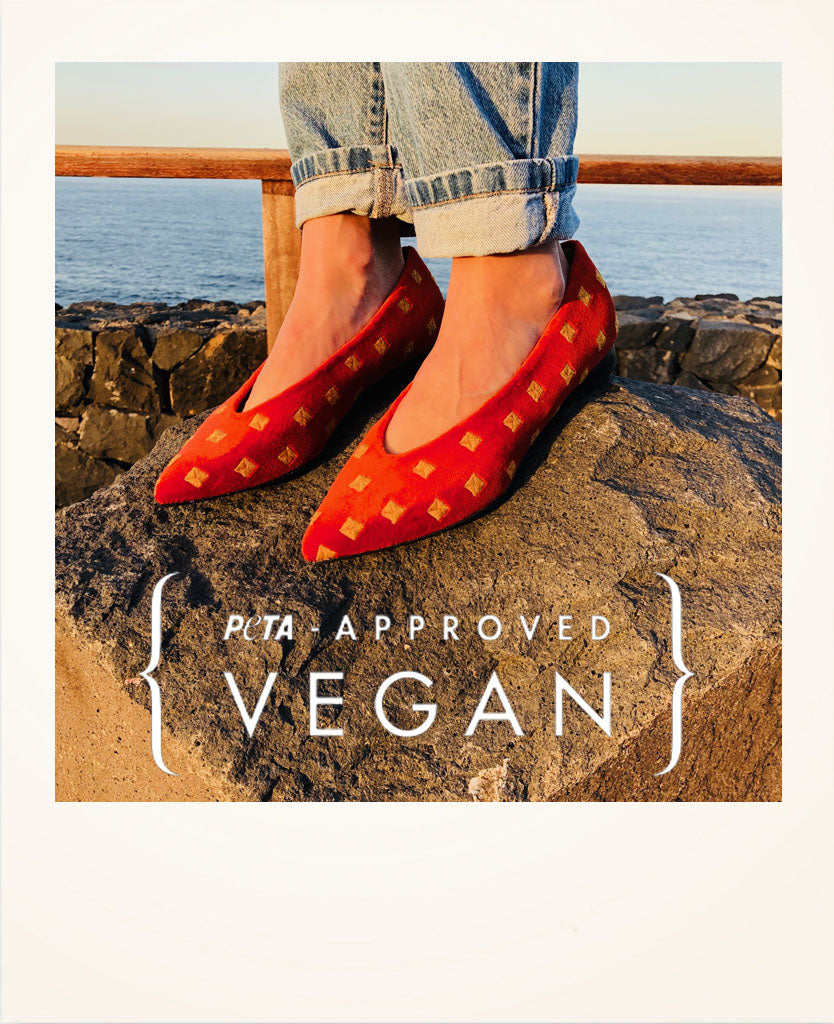Good news! We've earned PETA's cruelty-free seal of approval. PETA, or People for the Ethical Treatment of Animals, is the world's largest animal rights organization, with more than 6.5 million members and supporters. This seal means that from now on, every shoe or item we make will be completely free of animal products.
When we began this adventure, we started out as a solely sustainable brand. Our main goal was to reduce our carbon footprint, and our efforts were primarily focused on caring for our planet. But as we grew and the brand took on a life of its own, we realized that our concern for the environment wasn't enough. We wanted respect: for humans, animals, and the environment. Going vegan was the next logical step.
In today's article, we want to tell you a little more about the materials we use. You've probably heard us talk about them on our Instagram . They're recycled, GRS-certified, and all that. But what exactly does that mean?
Let's see what's hidden behind each piece of a Momoc shoe:
Lining and insole: made of eco-suede, chrome-free

Traditional suede is a type of leather that comes from the underside of an animal's hide. It's soft and one of the most coveted materials in the fashion world. Fortunately, one day an Italian manufacturer decided to create the first eco-friendly suede material using recycled polyester fibers and PET (polyethylene terephthalate) products , which would reduce energy consumption and CO2 emissions by 80%, without the use of any animals.
This material guarantees sustainable production from start to finish, with low levels of pollution and energy consumption. With a production similar to that of recycled paper, there would be no need to use harmful chemicals or toxic solvents . Furthermore, this material lasts longer than traditional suede and is able to maintain the same softness and comfort.
In addition to using this alternative to traditional suede, we ensure that the process is 100% chromium-free . Despite being carcinogenic, allergenic, and highly polluting, chromium is still a common element in the fashion industry today. “In the fashion industry, chrome tanning has been used for decades to produce luxurious, durable, and vibrant leather. But what many consumers don't realize is the environmental impact it has ,” explains Tara Savarese for Peacock Plume . “This cocktail is chilling: it includes salt, arsenic sulfide, and a heavy metal chromium.” Once used, it is often disposed of haphazardly and can even poison the waterways of countries that don't have protocols for managing toxic waste.
The sole: made from recycled tire

To create our tire soles, we work with a Spanish supplier, a company dedicated to the manufacture of high-tech products made from recycled tires. "With a clear commitment to the environment and sustainable development, our mission is to extend the useful life of discarded tires by developing products with high added value thanks to their mechanical and physical properties."
Our supplier has developed a sole made from genuine tire tread that provides extraordinary wear resistance and excellent grip on all types of ground and in all weather conditions. Through a highly qualified process, the tread ( 100% metal-free ) is extracted, creating slabs that can be transformed into shoe soles. "We want to do our part to improve the planet by recycling materials and reducing CO2 production without using any chemical, thermal, or tire-shredding processes. For every pair of shoes that use our soles, we save 0.06 kg of CO2 ."
The cut: made either with vegan wool embroidered on 100% cotton velvet or with recycled vegan materials (cotton, polyester, and other fibers)

As you may know by now, livestock is one of the biggest causes of greenhouse gas emissions, water consumption, and deforestation worldwide. Fortunately, trends are changing, and with it, the materials used. The days of vegan fashion featuring looks made from head-to-toe plastic are long gone, and companies are now increasingly looking for alternatives to traditional materials . “As consumers become more aware and realize they can no longer justify the negative impacts of using animals in fashion, the demand for vegan materials is growing,” says Good On You .
To make our shoes, we focus on three main materials: vegan wool, cotton velvet, and vegan recycled materials like cotton, polyester, and other fibers. Today we're focusing on organic cotton, vegan wool, and recycled polyester .
Organic cotton : Did you know that conventional cotton is one of the crops that requires the most water and chemicals? The effects are devastating for both the environment and those who grow it. “Fortunately, the fashion industry has embraced the benefits of GOTS-certified cotton, which minimizes its environmental impact by eliminating the use of carcinogenic pesticides and other chemicals from the production process ,” notes this article from Good On You .
Vegan Wool : In an article written by Ashley Palmer for PETA , Ashley shares that as a vegan, one of the questions she gets asked the most is about wool. Many people have an idyllic image of sheep grazing in green meadows, but as with any industry that uses animals for profit, money always comes before animal welfare. There's a common misconception that the wool extraction process is like a simple sheep haircut. But the reality is that several undercover investigations have revealed systemic cruelty and abuse of these animals, which must end as soon as possible. Furthermore, sheep are very similar to cows in terms of their environmental impact, as sheep "emit large amounts of methane gas" ( PlantBasedNews ), which contributes to global warming. Therefore, our wool is not only vegan but also eco-friendly . If you want to learn about the sustainable alternatives to wool that currently exist, we recommend reading this article from PlantBasedNews.
Recycled polyester . You've probably heard of or seen polyester written everywhere forever. But what exactly is polyester? "Polyester is a type of plastic resin obtained from petroleum through a series of chemical processes. Although there are many possible variants of polyester, the best known is the thermoplastic called PET (synthetically formed from ethylene glycol and dimethyl terephthalate)" ( Textilon ). In other words, polyester is a type of plastic . Luckily, thanks to the rise of sustainable fashion, materials like recycled polyester are becoming more common. Recycled polyester is made from recycled plastic bottles, which means it minimizes waste and reduces fossil fuels . Still, at Momoc we always look for the most sustainable alternative and avoid the use of plastic as much as possible, so we will continue searching and researching to find the best option for our shoes.
The heel, made of 100% recycled wood

Generally, aluminum, glass, paper, and plastic from construction sites are recycled, but for some reason, wood is largely forgotten (even though up to 17% of waste ends up in municipal landfills). Turning it into a heel gives it a second life. Our heels are handmade and dyed black. If you notice, no two Momoc heels are exactly the same. And that's the beauty of recycled fashion!
Why use reclaimed wood? “Reclaimed wood is environmentally friendly . It can be reused or recycled and eliminates the need to manufacture new wood, saving all that energy invested in turning a tree into lumber,” says Starre Vartan , founder and editor-in-chief of Eco-Chick. “Reclaimed wood requires a low-impact manufacturing method. It also limits deforestation —too much wood is harvested today from old-growth forests or unsustainably managed forests. When these trees are cut down, the entire ecosystem is negatively impacted.”
Now that you know a little more about each material, we want to tell you about Recover , a company we work with to make all of this possible. Recover is dedicated to promoting a zero-waste fashion industry with a textile upcycling system that transforms textile waste into high-quality yarns over multiple life cycles. “We use textile waste as raw material, preventing it from going to landfills and incineration. We are less dependent on virgin raw materials, we don't use water or chemicals, and we reduce CO2 emissions and energy consumption .”
Want to know what sustainable shoe production looks like? This chart will help you understand it better:




